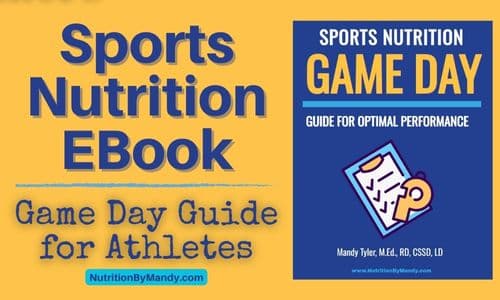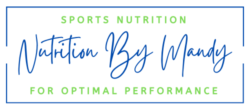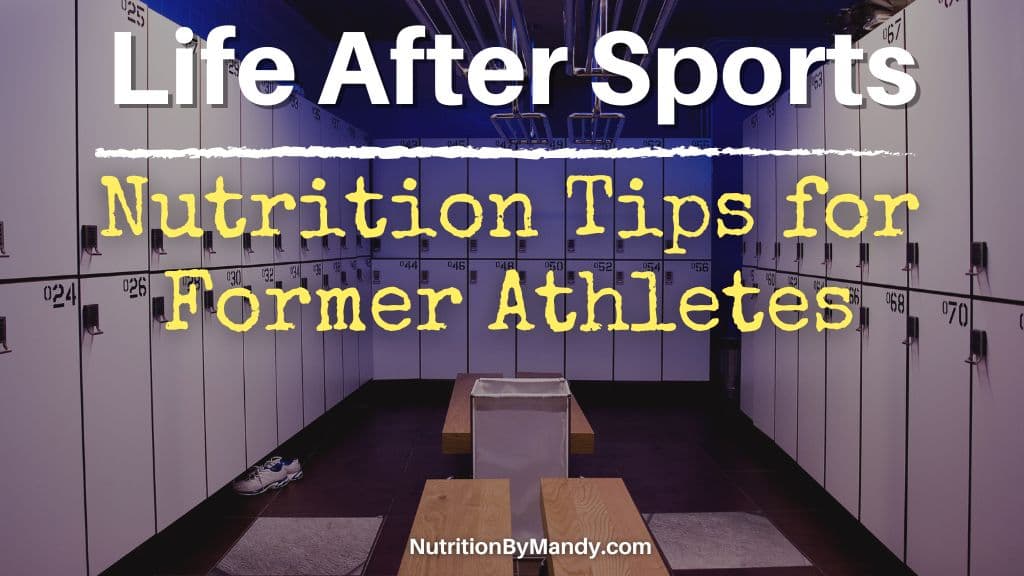Life After Sports: 9 Nutrition Tips for Former Athletes
It can be a challenge for athletes to know how to adjust their diets as they prepare for life after sports.
Providing nutrition guidance to athletes to support a healthy lifestyle as they transition out of competitive sports is important.
Here are 9 nutrition tips to share with athletes as they prepare for life after sports.
Competitive athletes are often encouraged to consume a diet high in carbohydrates to fuel their intense training and competition schedule.
#1 Life After Sports: Adjust Your Plate
When participating in competitive sports, athletes expend a high number of calories in training and competition. As athletes transition out of sports, their daily calorie needs are reduced.
To accommodate their decreased calorie needs, former athletes should adjust the types of foods they fill their plates with.
When building a performance plate, it is common to recommend that athletes fill a large portion of their plate with carbohydrates, such as rice, pasta, and potatoes.
For example, on intense training/competition days it is recommended that athletes fill half of their plates with carbohydrates to support their high levels of activity (1).

As athletes transition out of sports, and have a decrease in daily activity, they can reduce the amount of carbohydrates in their diet. Instead of filling half of their plates with carbohydrates, they can reduce the amount to a fourth of the plate.
Filling a quarter of the plate with carbohydrates (whole grains) is in alignment with the USDA MyPlate recommendations for building a healthy plate.
Of course, on days when they will be participating in more intense or prolonged activity, they can bump up their carbohydrate intake to support their increased energy needs.
#2 Increase Fruits and Vegetables
As athletes reduce the amount of carbohydrates on their plate, I encourage them to fill that space with a variety of fruits and vegetables.
Fruits and vegetables contain fiber, vitamins, minerals, phytochemicals, and antioxidants making them a nutritious addition to meals and snacks.
Going back to the plate concept, aiming to fill half of their plate with fruits and vegetables is a great goal.
Tips for adding fruits and vegetables to meals and snacks include:
- Add fresh berries to your morning oatmeal or yogurt
- Mix diced tomatoes, onions, or spinach into your scrambled eggs
- Add a handful of leafy greens into a healthy fruit smoothie
- Pile a variety of fresh vegetable toppings onto your sandwich at lunch
- Pack baby carrots, cucumber slices, mini peppers, and celery sticks with hummus to enjoy as a snack
- Start your dinner with a salad made with leafy greens and fresh vegetables
- Mix vegetables into your pasta or rice dishes
- Steam, grill, or roast vegetables to enjoy as a side dish
- Enjoy a Greek yogurt and fruit parfait as an evening snack
#3 Life After Sports: Focus on Fiber-Rich Foods
Dietary fiber is an important component of a healthy, well-balanced diet. Consuming a diet high in fiber is associated with numerous health benefits, including a reduced risk of developing many chronic diseases (2).
Despite the importance of dietary fiber, the majority of Americans do not consume the daily recommended amount of fiber(2).
I find this particularly to be the case with competitive athletes, as many sports foods, such as shakes, bars, gels, and chews tend to be low in fiber.
As athletes transition out of sport, I encourage them to focus on including high-fiber foods in their meals and snacks.
Dietary fiber occurs naturally in plant foods, including: fruits, vegetables, whole grains, beans, and legumes. Thus, including a variety of whole plant foods in the diet is a good way to increase fiber intake.

Start the Day with a Fiber-Rich Breakfast
Starting the day with a high-fiber breakfast is an easy way to boost the fiber content of an individual’s meal plan.
Consider trying out these high-fiber breakfast ideas:
- Greek yogurt parfait made with mixed berries, chia seeds, and whole grain cereal
- Steel cut oatmeal with ground flaxseeds, dried fruit, and walnuts
- Avocado and egg toast on whole grain bread
- Whole grain waffles topped with strawberries and sliced bananas
- Protein overnight oats with chia seeds and blueberries
#4 Hydrate Right: Limit Empty Calories
As a competitive athlete, you may not have given much thought to the amount of empty calories you were consuming in the beverages you drank.
However, as you transition out of intense daily training and have reduced calorie needs, it is important to limit your intake of beverages containing empty calories.
Sugar-sweetened beverages, such as soda, energy drinks, sweet tea, and sugary coffee drinks, provide calories with limited other nutritional benefits such as vitamins and minerals.
Excess consumption of sugar-sweetened beverages can lead to weight gain and is associated with the development of chronic diseases. The sugar in these drinks can also lead to dental concerns, such as cavities (3).
In addition to sugar-sweetened beverages, the empty calories in alcoholic beverages can add up quickly as well. Excess alcohol consumption can also increase the risk of injury, mental health concerns, and the development of chronic diseases (4).
Thus, if you choose to drink, make sure to do so only in moderation.
The Dietary Guidelines for Americans defines moderation as 2 alcoholic drinks or less in a day for men and 1 drink or less in a day for women.
Make Water the Go-To Choice
One healthy strategy that former athletes should focus on is making water their go-to drink of choice.
Aside from water, other healthy beverage options include:
- Unsweetened sparkling water
- Infused water
- Low-fat milk
- 100% fruit or vegetable juice (in moderation)
Easy Infused Water
Making infused water does not have to be complicated. Simply add a few slices of cucumber, fresh berries, or a lemon wedge to your reusable water bottle in the morning.
Each time you refill your water bottle throughout the day the water will be enhanced with a refreshing flavor. I find this strategy works well for individuals who enjoy having a flavored beverage to sip on throughout the day.

#5 Life After Sports: Eat Real Food
When athletes are involved in competitive sports, it is common to rely on sports foods (bars, shakes, gels) to help support their nutrition needs. This is particularly the case when time is limited and athletes are expending a high number of calories in frequent practices and competitions.
As athletes transition out of competitive sports, I encourage them to start relying on real, whole foods to meet their nutrition needs.
For example, instead of grabbing a protein bar for an afternoon snack, enjoy Greek yogurt or cottage cheese topped with fruit. Similarly, instead of a protein shake, drink a glass of high-protein milk.
Eating whole foods provides the added benefits of fiber, vitamins, minerals, and phytochemicals that can often be missing in sports foods.
#6 Make Eating Healthy Easy with Meal Prep
As athletes transition out of sport, planning ahead is key to supporting healthy choices.
Taking time to meal prep on the weekends can help ensure you have nutritious food available for meals and snacks throughout the week.
Before saying that meal prep is too difficult or that you don’t have time, realize that meal prep does not have to be complicated to be effective.
Taking small, simple steps to prep meals in advance can help set you up for nutrition success during the week.
Below are a variety of meal prep strategies to help get you started.

Start with a Plan
The first step to meal prep is making a plan. Start by reviewing your schedule for the upcoming week. Determine which specific meals and/or snacks you want to focus your meal prep efforts on.
If you have any commitments during the week that will interfere with meals, make sure to plan in advance for these days.
Also consider times during the week when you may be rushed and having food prepared in advance would be of help. For example, breakfast on-the-go for busy weekday mornings or healthy afternoon snacks to enjoy on your drive home from work.
Once you have a plan for the week, make a grocery list of the items you need and head to the store.
Get the Easy Tasks Done at Once
When you get home from the store, prep the ingredients you will need for meals and snacks throughout the week.
Taking the time to prep the items all together allows you to get all the cooking and cleaning done at once, which will save you time on busy weekdays.
Ideas include:
- Hard-boil eggs
- Wash and chop fresh fruits and vegetables
- Pre-package snack items into individual serving containers
- Prepare overnight oats for breakfast during the week
Meal Prep Double
Another easy meal prep strategy is to double the recipe when preparing your favorite dishes. Once prepared, you can freeze half of the meal to enjoy at a later time.
You can also prepare double the quantity of a single ingredient that will be used in multiple meals within the week.
For example, you can prepare a large batch of rice or quinoa to eat as a side dish with your meals throughout the week. You can also cook several pounds of lean ground beef when you meal prep. Then you can use the ground beef with meals such as spaghetti, chili, or taco salad during the week.
#7 Life After Sports: Plan Balanced Snacks
Taking time to plan ahead and pack balanced snacks can help you stay on track with your nutrition goals. Having a healthy snack available can help prevent a trip to the vending machine mid-afternoon for a sweet treat.
When planning a balanced snack, aim to combine a food that provides a good source of protein with food from another food group.
Example snacks may include:
- Peanut butter with apple slices
- Hummus with mini peppers
- Cheese stick with grapes
- Almonds with pretzels
- Cottage cheese with pineapple
- Greek yogurt with berries
- Sliced cheese with whole grain crackers
- Greek yogurt dip with whole grain pita chips
- Turkey on a whole wheat wrap

#8 Make Healthy Choices When Eating Out
With busy schedules, eating out is a common reality for most individuals. Therefore, being equipped with ideas for making healthy choices at restaurants is important.
Choose a Restaurant with Healthy Options
When possible, plan ahead and select a restaurant where there are nutritious options available.
Consider checking the restaurant’s website or smartphone app to review the menu for healthy options. This can help you with determining which restaurants offer items that will support your daily nutrition needs.
Limit Fried Foods
When eating at restaurants select items that have been grilled, baked, roasted, or steamed instead of deep fried. Fried foods tend to be higher in saturated fat and less healthy choices.
Choose a Healthy Side item
At restaurants, order a healthy side item to enjoy with your meal. Instead of French fries or onion rings, order apple slices, fresh fruit cups, steamed vegetables, side salads, or fruit and yogurt parfaits, which are all healthy choices.
Get the Sauce on the Side
Be mindful of the types of sauces that are added to your entrée and side items. Sauces made with butter or cream, gravies, and cheese sauces all tend to be high in calories and saturated fat and less healthy choices.
It is always best to order the sauce on the side. This allows you to control the amount added to your meal.
The same recommendation applies to salad dressings. Salads at restaurants often come covered in an excessive amount of salad dressing. Ordering the dressing on the side allows you to control how much you put on your salad.
Be Mindful of Portion Sizes
It can be easy to overeat at restaurants, as serving sizes are often large. When ordering your meal, consider packing half of the food into a to-go box to enjoy later.
Some restaurants will also allow you to order the lunch size serving at dinner, which can help you control portions and save money as well.
At fast food restaurants, avoid the temptation of super-sizing your meal. You are better off enjoying a smaller meal at the restaurant and eating a healthy snack later in the day if still hungry.
Download my Healthy Eating Out Guide for additional tips on making healthy choices at fast food restaurants.

#9 Practice Moderation
In general, all foods can fit into a healthy diet. The key lies in practicing moderation.
I like to share with athletes the “80/20 Rule” for healthy eating – the goal being to aim to make healthy food choices 80% of the time. The other 20% of the time, it is ok to enjoy your favorite, less healthy foods, in moderation.
Too often I find that when individuals overly restrict their diet it can lead to frustration, lack of enjoyment with food, and sometimes concerns with disordered eating.
Life After Sports: 9 Nutrition Tips for Former Athletes
You are now set with 9 nutrition tips to support athletes as they transition out of competitive sports.
For additional nutrition tips to share with former athletes, check out my blog on food to buy on a budget.
Join the Nutrition By Mandy Email List & Get a Free Weekly Meal Planner Template
Click HERE to join the Nutrition By Mandy e-mail list. When you join you will receive a free weekly meal planner template to download and plan out your meals for the week.
About the Author
Mandy Tyler is a Sports Dietitian Nutritionist in the San Antonio, TX area. She is a Registered and Licensed Dietitian, a Board-Certified Specialist in Sports Dietetics, a Licensed Athletic Trainer, and is a Certified Exercise Physiologist through the American College of Sports Medicine. Mandy has experience working with athletes at the high school, collegiate, and professional levels. She believes the key to reaching one’s full potential, both in everyday life and in sports performance, relies on a healthy nutritional foundation.

If you are looking to take your performance to the next level, make sure to check out my new Sports Nutrition Game Day Guide. This downloadable guide is written to help athletes develop an individualized plan to achieve peak performance on game day.

